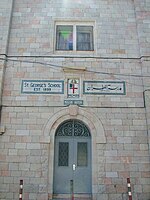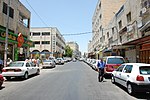Tombs of the Kings (Jerusalem)

The Tombs of the Kings (Hebrew: קברי המלכים Keveri HaMlakhim; Arabic: قبور السلاطين; French: Tombeau des Rois) are a rock-cut funerary complex in East Jerusalem believed to be the burial site of Queen Helene of Adiabene (died c. 50–56 CE), hence: Helena's Monuments. The tombs are located 820 meters (half a mile) north of Jerusalem's Old City walls in the Sheikh Jarrah neighborhood (Hebrew: שכונת שייח ג'ראח; Arabic: حي الشيخ جرّاح) The grandeur of the site led to the belief that the tombs had once been the burial place of the kings of Judah, hence the name Tombs of the Kings; but the tombs are now associated with Queen Helena of Adiabene. According to this theory, Queen Helena chose the site to bury her son Isates and others of her dynasty. More recent research by noted French scholar and Dominican friar Jean-Baptiste Humbert has concluded that the tomb was likely designed for Herod Agrippa I, the grandson of Herod the Great.The site is located east of the intersection of Nablus Road and Saladin Street. The gate of the property is marked "Tombeau des Rois", French for "Tomb of the Kings."
Excerpt from the Wikipedia article Tombs of the Kings (Jerusalem) (License: CC BY-SA 3.0, Authors, Images).Tombs of the Kings (Jerusalem)
Salah ad Din, Jerusalem Bab a-Zahara
Geographical coordinates (GPS) Address External links Nearby Places Show on map
Geographical coordinates (GPS)
| Latitude | Longitude |
|---|---|
| N 31.788519444444 ° | E 35.229188888889 ° |
Address
קברי המלכים
Salah ad Din
9119001 Jerusalem, Bab a-Zahara
Jerusalem District, Israel
Open on Google Maps







